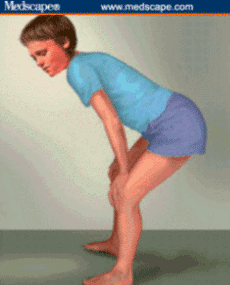Pompes Disease
return to Pompes page
~ July 2020 No.1 ~
New Clinical Findings in Pompe Disease, Also Known as Acid Maltase Deficiency: Evidence-Based Cases in Infantile- and Late-Onset Patients
Patients with late-onset Pompe disease, with symptom onset in childhood or adulthood, present a diagnostic challenge. Their clinical symptomatology is dominated by skeletal and respiratory muscle weakness. Nearly all patients have progressive proximal muscle weakness, especially in the axial muscles and proximal pelvic girdle muscles. They frequently note changes in gate and difficulty walking up stairs or rising from low chairs. The pelvic girdle weakness may culminate in frequent falls. Axial muscle wasting and weakness reduces difficulty with trunk extension. To fully extend the spine, cheat maneuvers such as placing the hands on the knees to achieve full spinal extension are frequently used (Figure 3). Progressive pelvic girdle weakness usually precedes symptomatic upper limb or respiratory muscle involvement by several years.

Figure 3. Modified Gower's maneuver in patient with late-onset Pompe disease.
Patient 2 illustrates a typical clinical course. However, in some patients, respiratory muscle weakness produces the presenting symptoms. The bellows muscles of respiration are involved in almost all patients with late-onset Pompe disease. As symptoms progress, spontaneous and exertional fatigue is often noted.[1] Early involvement of the diaphragm muscle is characteristic of Pompe disease and produces symptoms of nocturnal hypoventilation. Diaphragm weakness can be documented by determining a more than 10% fall in VC when supine measurements are compared with VC determination performed seated or standing.
As the disease progresses, sequential difficulties with sleep-disordered breathing and recognition of supine shortness of breath (orthopnea) evolve. Some patients have respiratory failure and sleep-disordered breathing as their target symptoms, as illustrated by patient 3.
Other clinical findings include spinal deformities, especially scoliosis and exaggerated thoracolumbar lordosis. Pelvic girdle weakness is invariably more prominent than shoulder girdle weakness. However, early scapular winging is an important clinical clue to the diagnosis of Pompe disease (Figure 4). The skeletal myopathy of late-onset Pompe disease is invariably progressive and has a profound impact on quality of life.[10] However, the diagnosis is usually delayed for several years after symptom onset. More common diseases such as limb girdle muscular dystrophy, Becker muscular dystrophy, and polymyositis are often considered before Pompe disease even enters the differential diagnosis.

Figure 4. Hyperlordosis and scapular winging.
The nonspecific finding of elevated CK is common to both Pompe disease and these more common progressive myopathies. Needle electromyography studies usually demonstrate findings of a myonecrotic myopathy including fibrillation potentials and early recruitment of short duration motor units. The widespread myotonia seen in infant-onset patients is usually not present in adults; however, localized paraspinal myotonia may be present and serves as an important clinical clue.
continue to next page Limb Girdle syndrome